In this review, we delve deeper into the World of Legend. We traverse the history from The End Times through Age of Sigmar to the Warhammer: The Old World Revue, flip through the new rulebook, and venture a preview of the upcoming books and releases.
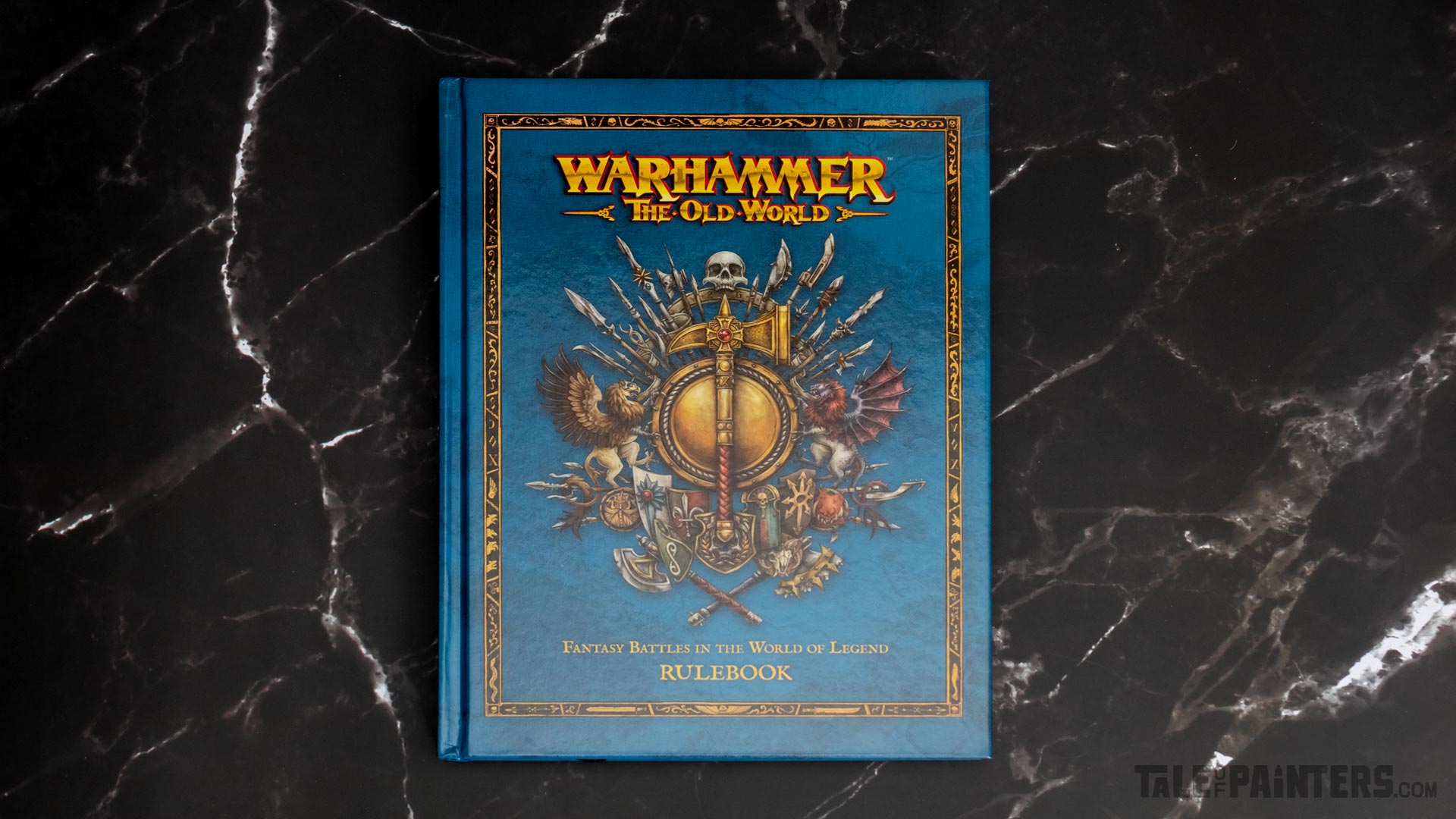

Warhammer: The Old World is launching with a huge wave of Bretonnian and Tomb Kings releases. Check out our review of the Tomb Kings of Khemri Core Set here. The preorder allocations have been sold out at most retailers, but Games Workshop will continue production so that the products should be available again in a few weeks or a few months.
From The End Times to Age of Sigmar and back again
I must admit: Back in the day when it became clear that Games Workshop would discontinue Warhammer Fantasy and reboot it as Age of Sigmar, I was a bit disgruntled. Changes are always hard to swallow, and The Old World was a cherished setting for me. Initially, I struggled to warm up to Age of Sigmar. While I liked the minimal ruleset, the initial lack of points and the introduction of “Sigmarines” took some getting used to.
However, Warhammer: Age of Sigmar has since evolved into a standalone setting that firmly stands on its own thanks to the ingenius creativity of Games Workshop’s designers. Yet, the call for a return to a proper rank-and-file system persisted in the small but vocal WHFB community. Then, in November 2019, the sensation occurred: Likely because of the success of Total War: Warhammer 3, Games Workshop teased that Fantasy would return as Warhammer: The Old World.
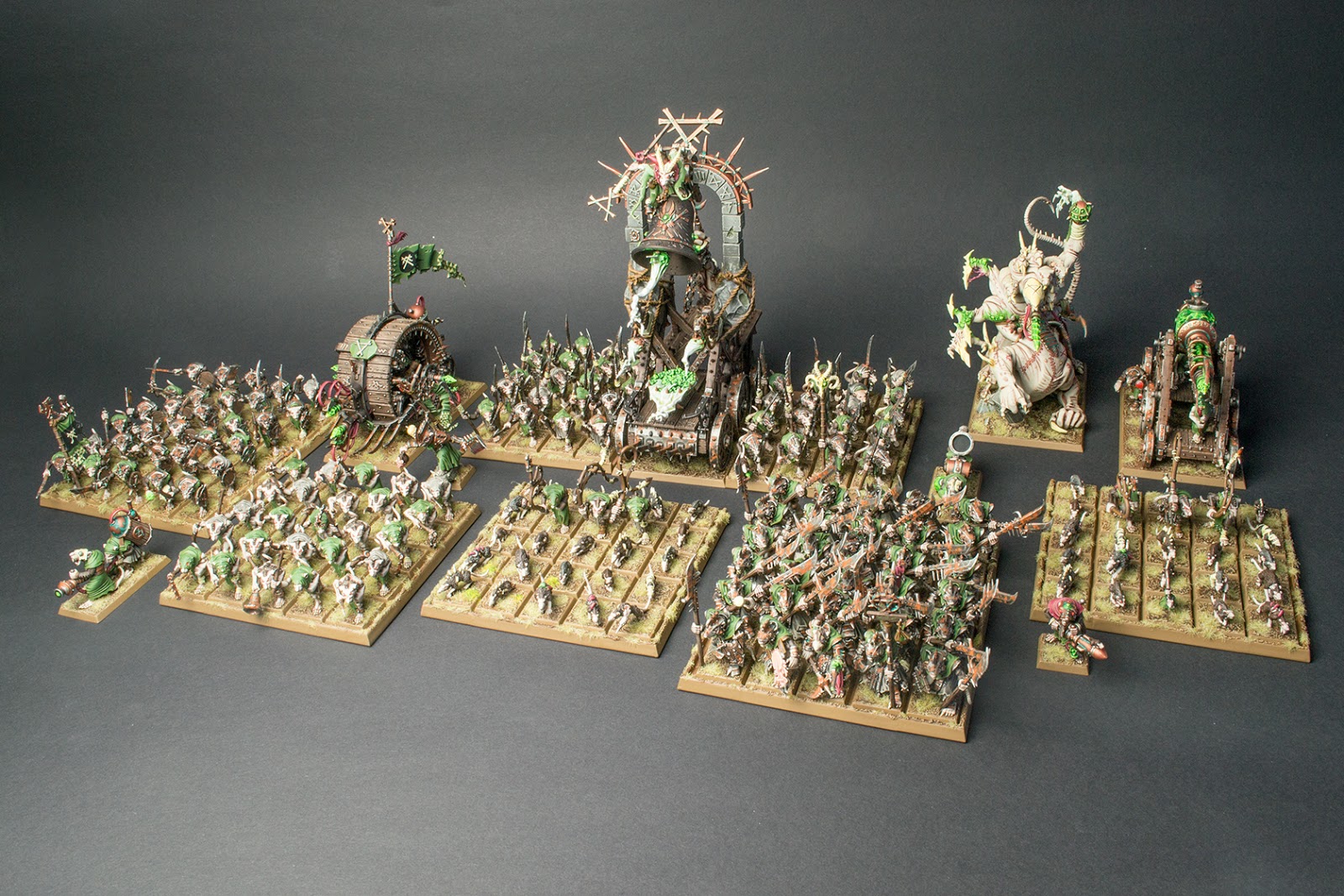

Games Workshop chose to involve us in the design process much earlier than usual. This meant that we could witness how the project’s focus shifted. Initially, Kislev was boldly promised as a new playable faction, which was playing a central role in Total War: Warhammer 3. Later, it became clear that the game would have a prequel setting, akin to The Horus Heresy, set far before the events of the WHFB timeline and The End Times. The focus was narrowed, conveniently writing out all the factions whose models had found a new home in Age of Sigmar – namely Skaven, Soulblight Gravelords/Vampire Counts, Seraphon/Lizardmen, Chaos Daemons, and even Dark Elves (although they had received a completely new range of miniatures just shortly before The End Times). Surprisingly, the “lost” factions of Bretonnia and Tomb Kings became the poster boys for the new edition instead, and it became apparant that the miniature range would mainly consist of a reissued old models. It was far from the “fourth core game” that many in the WHFB community had dreamed of.
I personally had the “fortune” not to be led too much by false promises. I didn’t set my expectations too high; I anticipated support similar to Middle-earth, meaning mainly resin kits with the occasional new plastic model, and occasional Made to Order re-releases of old models. At least Games Workshop seems to surpass this, even though the level of plastic support that the second edition of The Horus Heresy got is not quite reached. Whether that’s enough to rekindle the enthusiasm of the Fantasy community remains to be seen. Almost all products sold out at the weekend, but this was probably due to low quantities rather than huge demand. So will it hip to be square again? We’ll see. Let’s take an unbiased look at the new rulebook and setting in this review.
Warhammer: The Old World rulebook review
The new The Old World rulebook follows the typical hardcover format for Games Workshop. The tome comprises 352 full-color pages with a bookmark ribbon. A glance at the table of contents reveals that there are about 90 pages of lore, a 38-page miniature showcase, and over 220 pages of rules. Phew. Let’s take a closer look at each section.
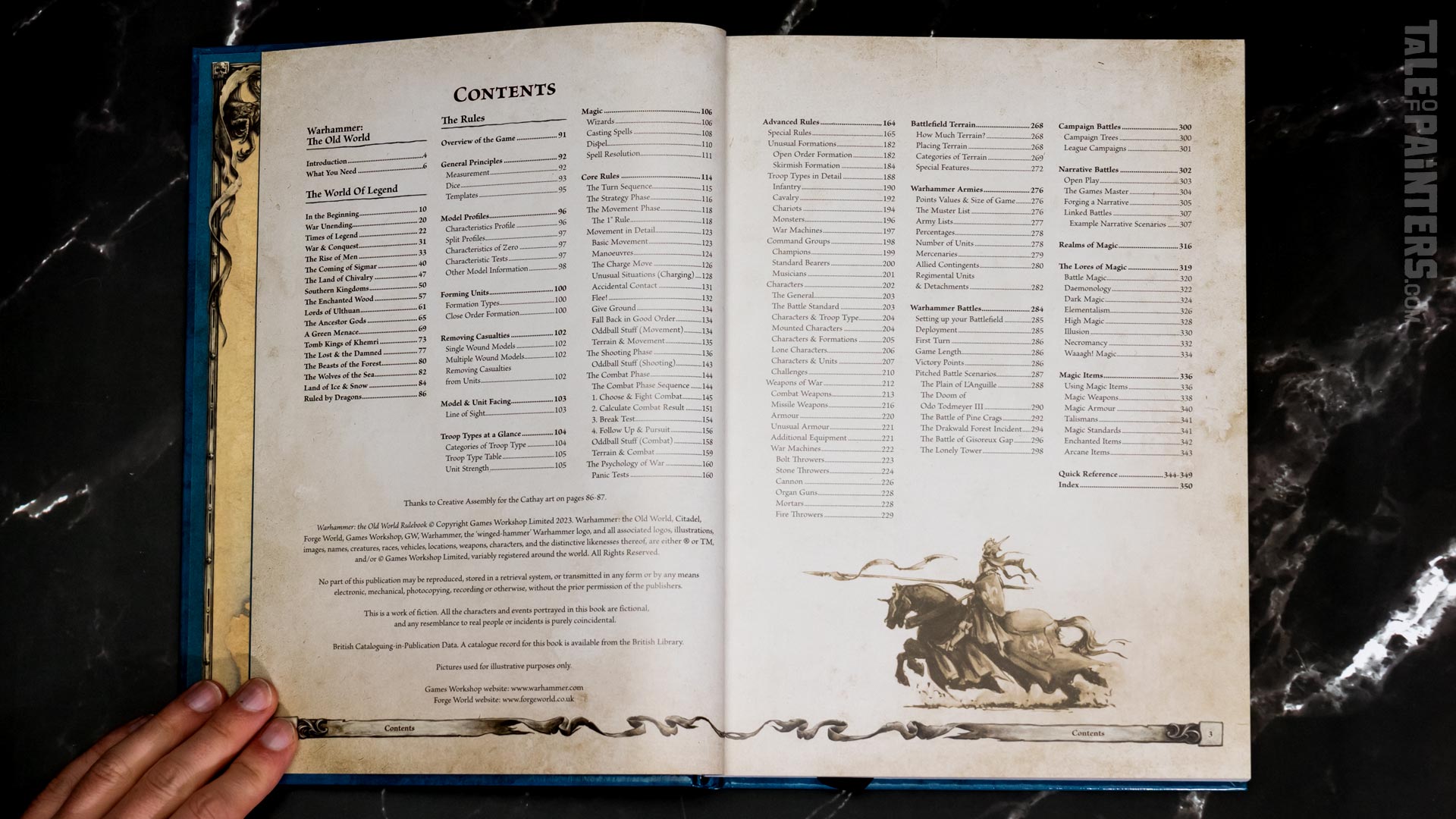

Lore & miniature showcase
The 90-page lore section begins with an intro to the setting and 8-page timeline, based on the timeline from the 8th edition rulebook but expanded and partially rewritten. It starts in the year -15000 with the arrival of the Old Ones and ends just before the Siege of Praag. Following this, there is a detailed description of the setting, which is set several hundred years before what we know from Warhammer Fantasy. Then, each of the 9 factions that are the focus of this edition are introduced: The Empire of Man, Kingdom of Bretonnia, the Dwarfen Mountain Holds, the High Elf and Wood Elf realms, the Tomb Kings of Khemri, Warriors of Chaos, Beastman Brayherds, and Orc & Goblin tribes. Kislev and Cathay are also covered in some detail, as well as Dogs of War and Tilea, so I still expect that we will see models for them, albeit at a later date. There are also side notes on Norsca, Albion, Ind, and Nippon. The other established fantasy races like Skaven, Dark Elves, Chaos Dwarfs, Lizardmen, and Ogres only appear in passing.
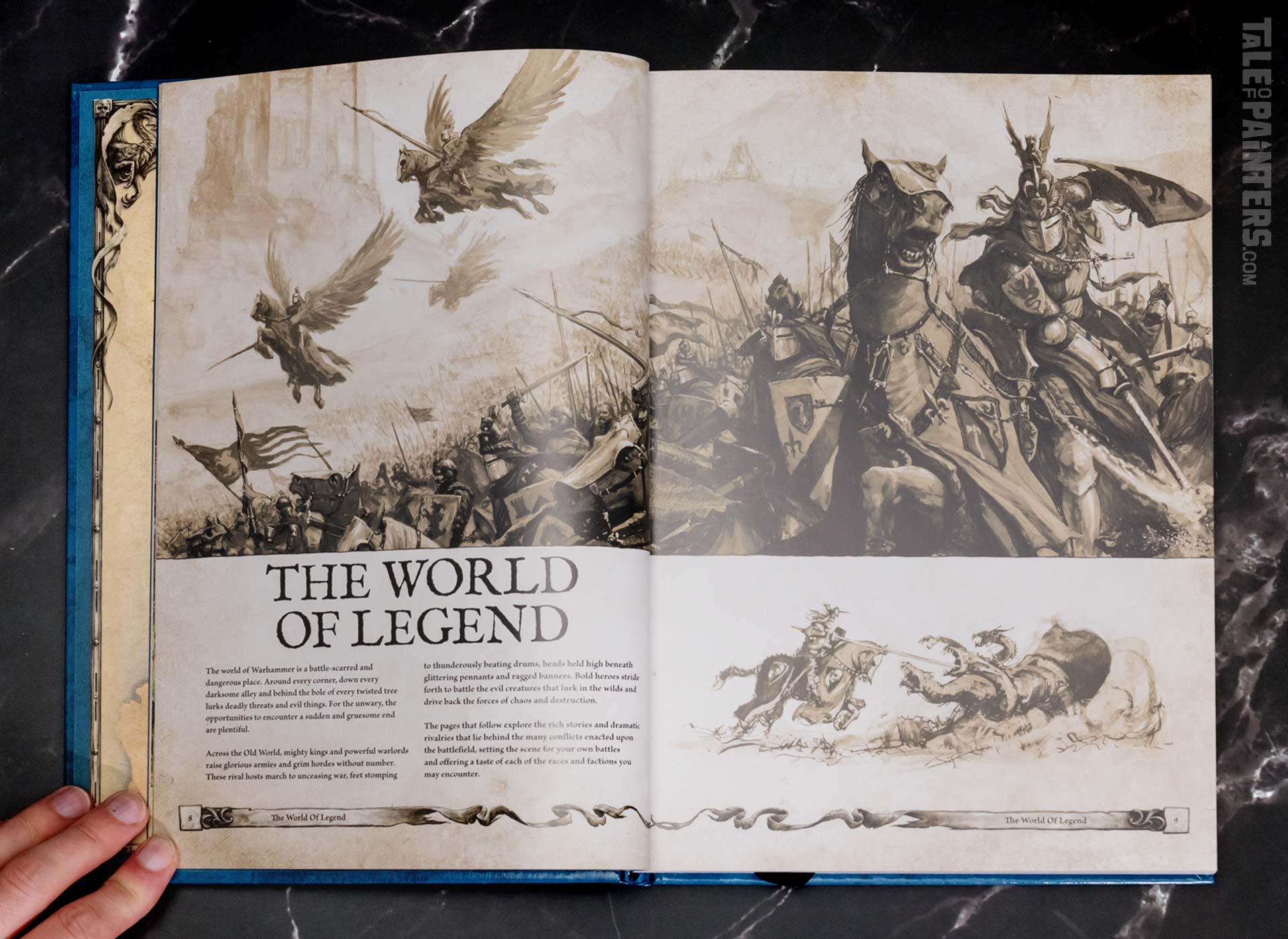

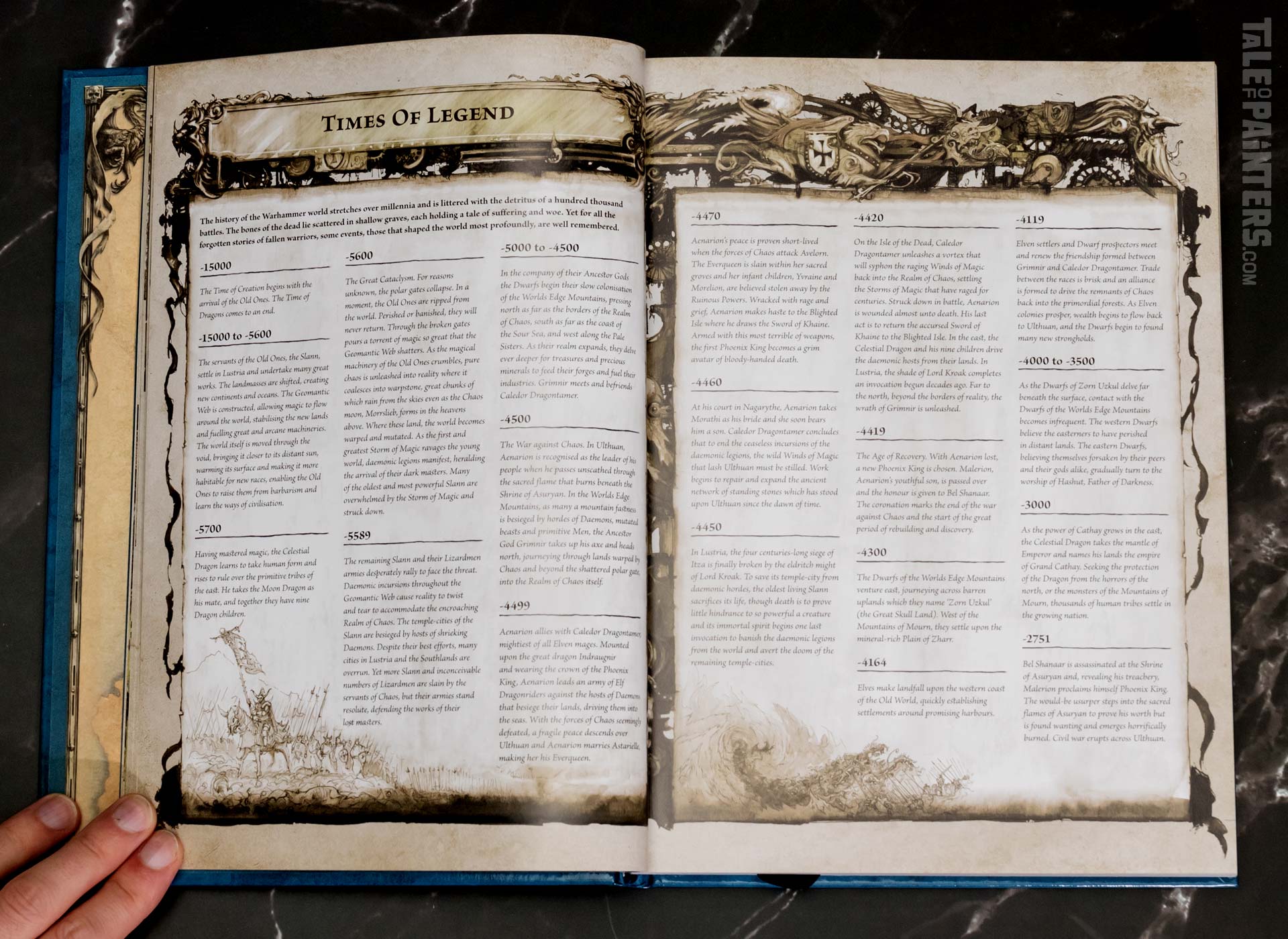

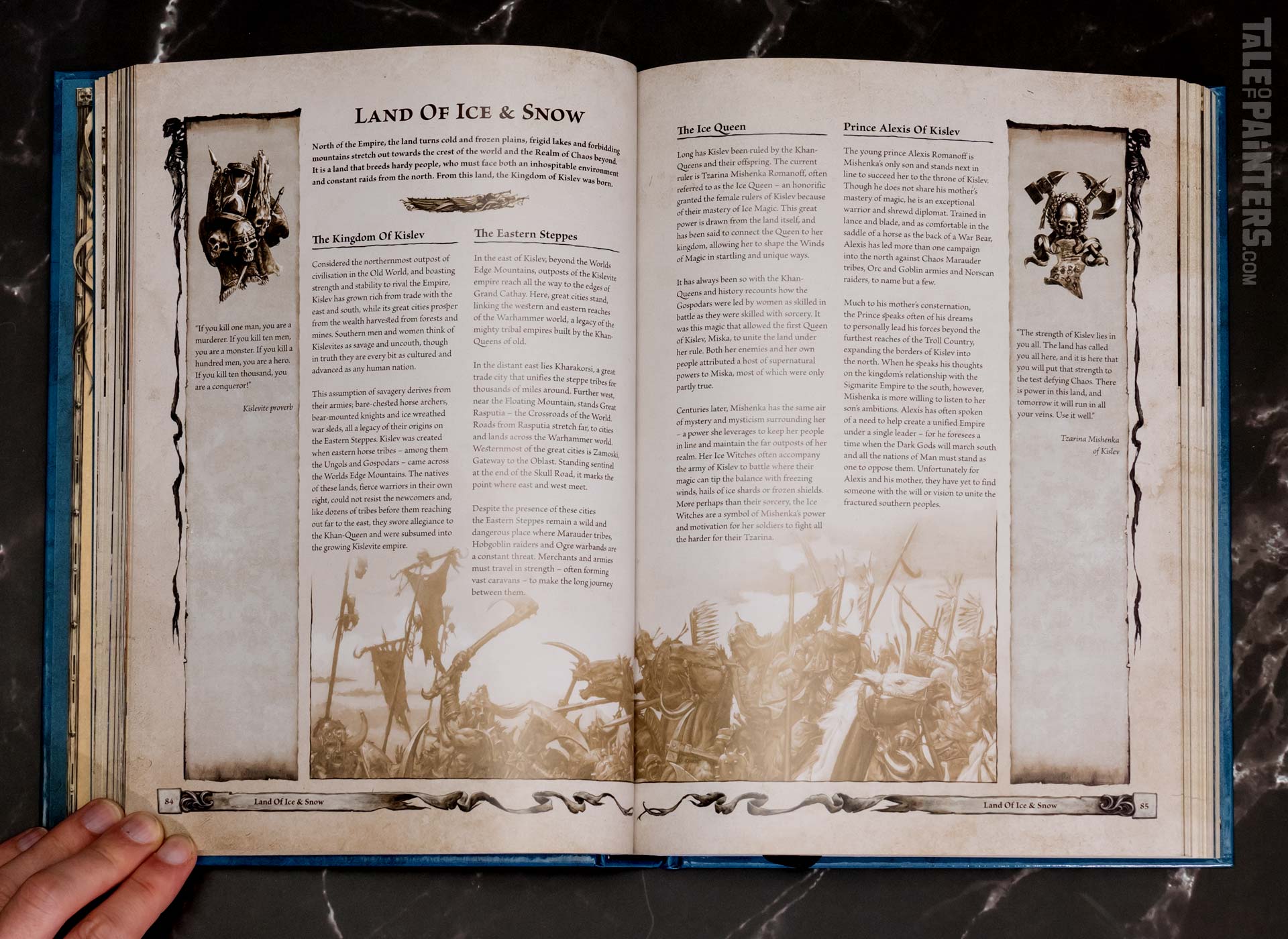

As for the presentation, it’s 99% old artwork. The many black and white illustrations from older army books have been recoloured in sepia tones, which adds a nice touch, and there is a beautifully designed new map of the Old World, which has been shown on Warhammer Community.
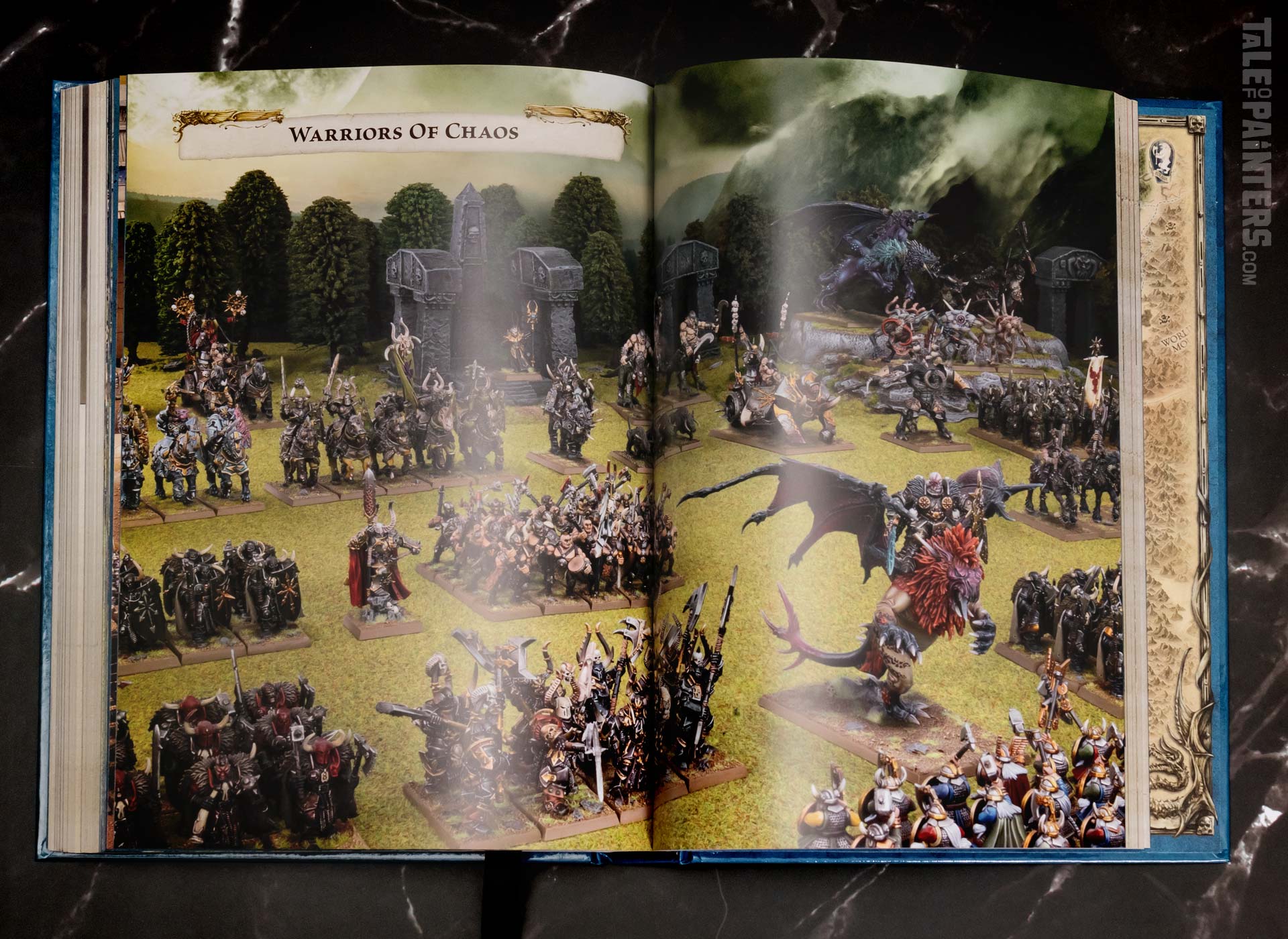

The Showcase section comprises approximately 40 pages and features images of the ‘Eavy Metal collection of the 9 races. The army photos are pleasantly old-school, featuring old Fantasy terrain kits, green flock, and a lot of homemade terrain. This section also gives an insight into how Games Workshop envisions Warhammer: The Old World visually. Only models released before The End Times are shown, along with the new models for Bretonnia and Tomb Kings. This means we see the old Chaos Warriors and Knights, the old Wood Elves Treeman and Treekin, while Night Goblins (which became Gloomspite Gitz in Age of Sigmar) are entirely absent from the Orcs & Goblins section.
The rules
The rule section overwhelms you with over 220 densely printed pages, quite a few more than 8th Edition had. The book doesn’t bother introducing the Warhammer hobby, as other core books from Games Workshop do, and a tutorial or introductory campaign for new players is conspicuously absent. The target audience of Specialist Games studio seems clear: WHFB veterans.
The rulebook represents a “Best of” the past editions, retaining the clear DNA of Warhammer Fantasy. The ruleset hasn’t become slimmer or streamlined, and in some aspects, it became even more complex. It’s a bit clearer in wording and structure though, but I really miss numbered paragraphs like in the 3rd Edition Age of Sigmar book.
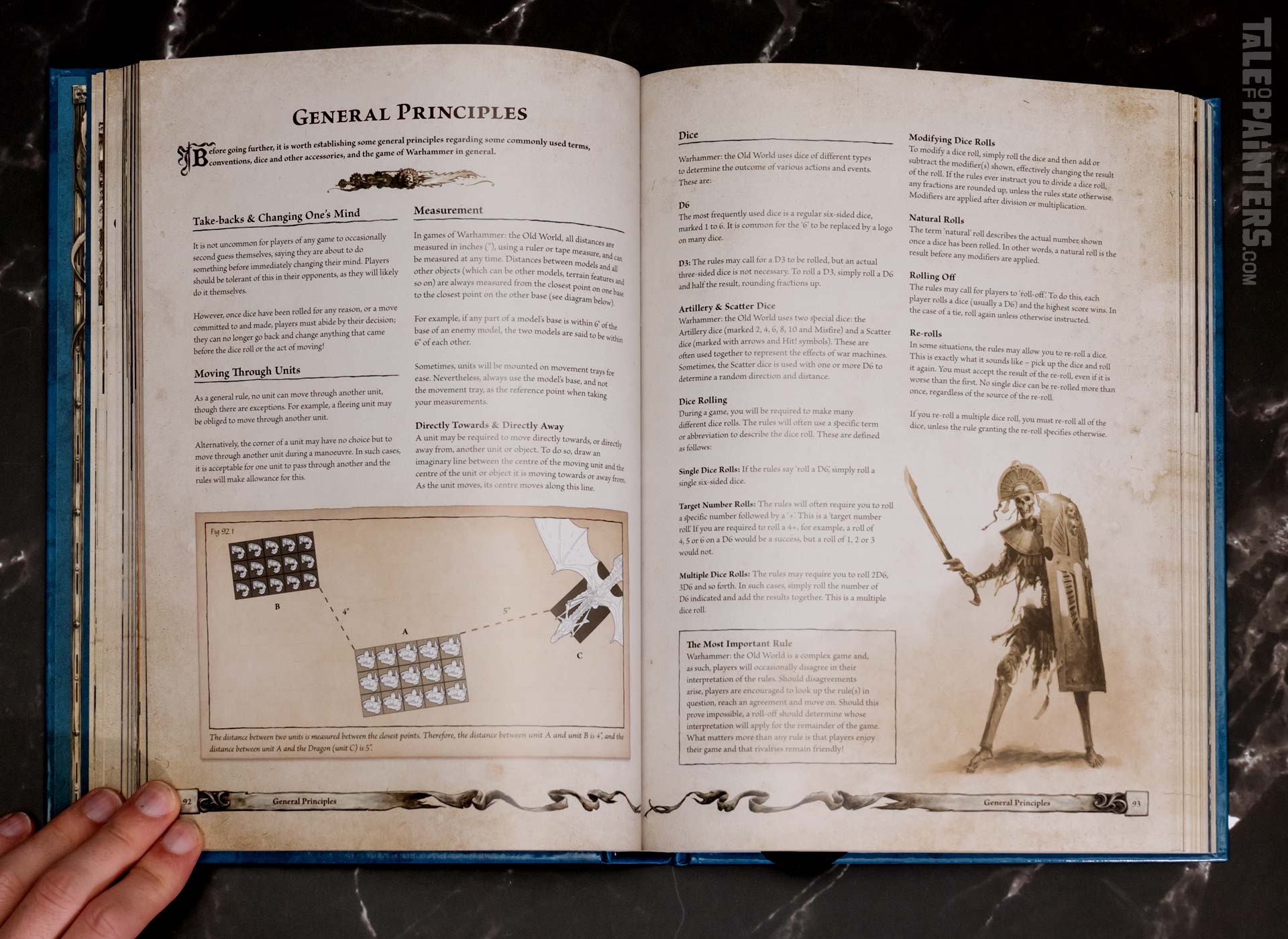

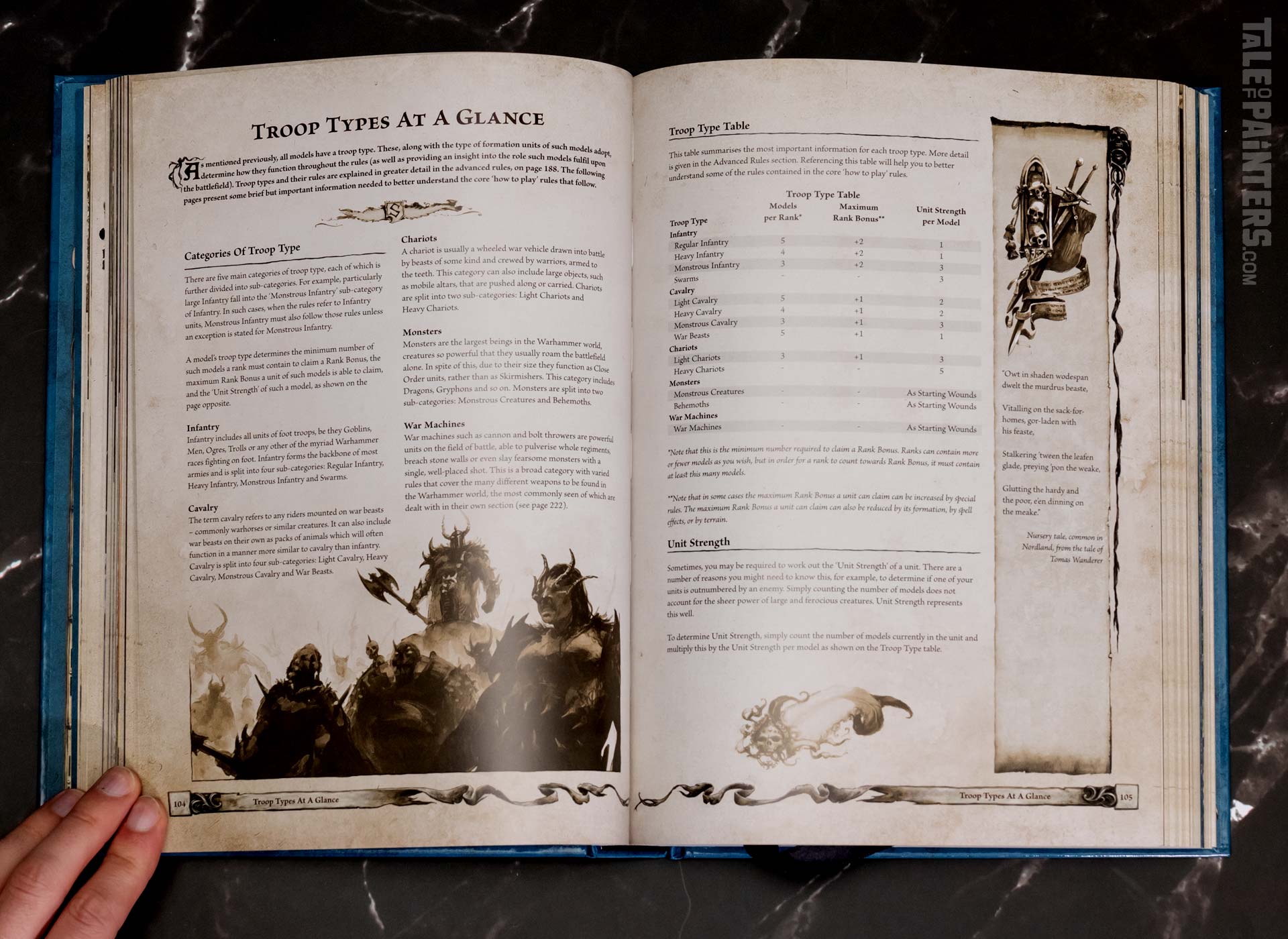

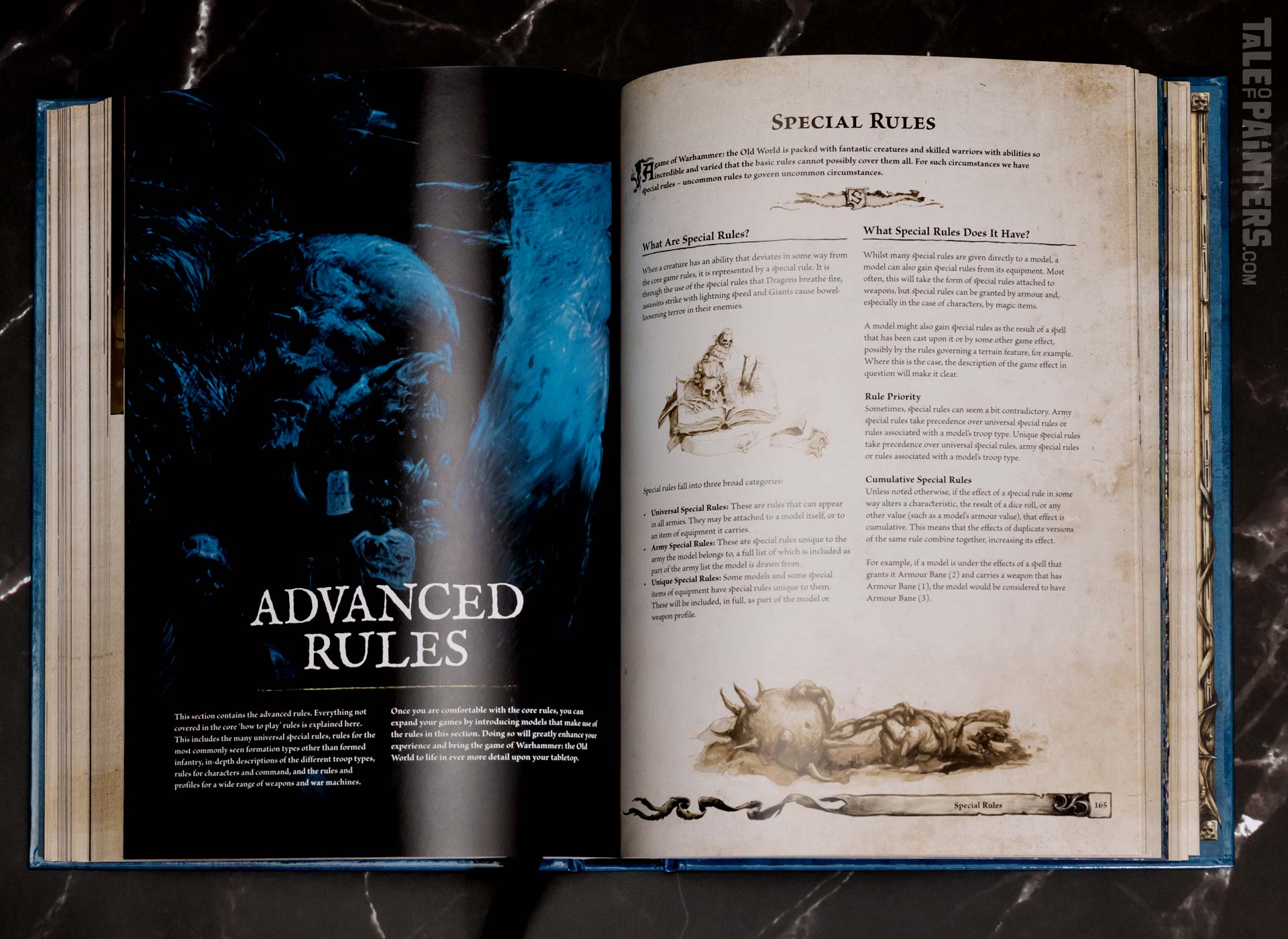

Some of the new features include the distribution of magic use across all phases, more granular unit types, weapons now having AP values, changes to the combat phase, more variable outcomes in break tests, and alternative army composition options reminiscent of detachments from the 10th Edition of Warhammer 40k.
All in all, it’s obvious that more effort went into this book than just simply reprinting the rules from a previous edition. If you’re looking for adjustments to modern gaming tastes, you will be wrong here (which might be a good or bad thing depending on your point of view).
Core sets & Arcane Journals
At the heart of the Warhammer: The Old World launch are the Bretonnians and Tomb Kings, both receiving packed army sets . These core sets include a truckload of plastic and the The Old World rulebook. You can find a review of the Tomb Kings set here.
Access to army lists require the purchase of source books, similar to The Horus Heresy. “Forces of Fantasy” includes Bretonnia, The Empire, Dwarfs, High Elves, and Wood Elves. “Ravening Hordes” contains Tomb Kings, Warriors of Chaos, Beastmen, and Orcs & Goblins. Games Workshop has promised to provide free PDF rules for classic WHFB armies that aren’t actively part of this edition through free rule downloads, but made clear that they won’t receive any support or balancing updates and also won’t be tournament legal.
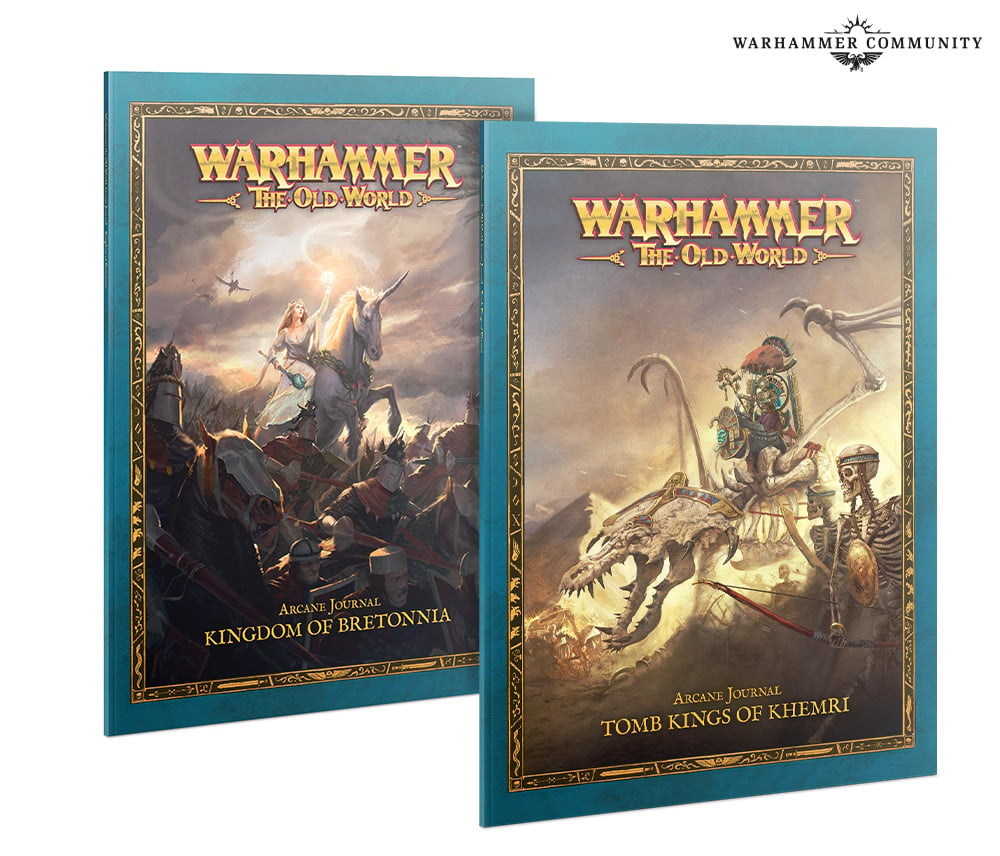

Both books will be released alongside with the rulebook and the new core sets for Bretonnia and Tomb Kings. It’s important to note that the core sets include the rulebook and a rules pamphlet for the models in the box, but not the complete army list, for which you will need the respective book.
However, because two books apparently can’t enough, the Design Studio, in its wisdom, introduced the Arcane Journals. These slim softcover books contain additional rules, special characters, magic items, spells, alternative army composition options, and lore. While the journals are optional, anyone wanting to explore all tactical possibilities and/or play characters like The Green Knight or Settra the Imperishable will need the journal.
I believe, for a game with a relatively small target audience, it would have been nice to offer these contents for free, but probably Games Workshop wants to sell a few more books since many veterans might own enough models already. At least, all the rule publications are available as EPUBs and not tied to a proprietary app.
Looking ahead
In addition to the books and core sets, reissues of sought-after old kits are coming, such as the Tomb Guard, Necrosphinx, Sepulchral Guard, and the Grail Reliquae for the Bretonnians. There are also some newly designed resin characters from Forge World. Most of the preorder allocations for those models are sold out at the time of this article, but Games Workshop confirmed via social media that they will produce more. Check here what’s available at the moment:
You can find the latest hobby products at our 🇬🇧/🇪🇺 partner stores Wayland Games, Element Games, and Firestorm Games, at 🇩🇪 Taschengelddieb and PK-Pro, and at 🇺🇸 Noble Knight Games with a welcome discount of up to 10–15% over RRP. Using our links helps to support Tale of Painters at no additional cost to you, so thank you very much for using them!
I hope you found this review helpful, feel free to leave a reaction or comment below, or post your questions here or discuss on our Discord channel.
7.5Score
Pros
- Beautiful hardcover book with lots of classic artwork
- Rules feel like a "Best of" previous editions with added clarifications and subtle modernisations
- Expanded lore section that explores an earlier period in The Old World timeline
Cons
- The rules section has swollen even more compared to the 8th edition
- No tutorial, no beginner's campaign, no game modes for lower point limits
- Hardly any new art pieces
Final Verdict
Giving a final rating is challenging for me. I'm pleased that the classic Warhammer Fantasy setting is back and actively supported once again, even if in a streamlined form as a Specialist Game. The shift in the time period feels fresh but still familiar. However, the expectations of the WHFB community are high. Whether The Old World will succeed will also depend on whether Games Workshop can fulfill the initial promises regarding new factions like Kislev. Additionally, it remains to be seen if the classic factions not part of The Old World will still be reasonably playable. Games Workshop has completely foregone making the system attractive to newcomers, so convincing WHFB veterans is crucial.








